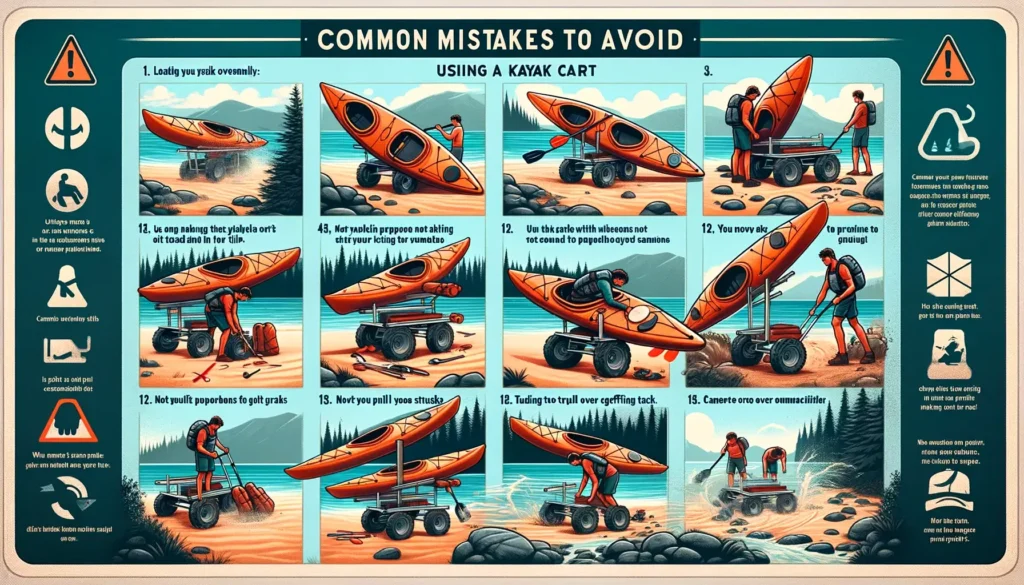When kayaking, you should secure the kayak cart by attaching it to your kayak using straps or bungee cords. This ensures that the cart remains secure and doesn’t interfere with your paddling.
Kayaking is an exhilarating water sport that offers an incredible opportunity to explore nature and enjoy the thrill of gliding through the water. However, one aspect that often poses a challenge for kayakers is how to handle their kayak cart while out on the water.
A kayak cart is a handy tool designed to transport your kayak from the parking lot to the water’s edge, making it easier to navigate over various terrain. But what do you do with the cart once you’re kayaking? We will provide you with the best approach for properly managing your kayak cart while enjoying your kayaking adventure. By following these simple steps, you can ensure a hassle-free and enjoyable experience on the water.
Transporting A Kayak Cart
Transporting a Kayak Cart:
Choosing A Portable Kayak Cart
When selecting a portable kayak cart, consider its weight capacity and durability.
- Opt for a cart made of rust-resistant materials for longevity.
- Ensure the cart can be folded or disassembled for easy storage.
- Look for pneumatic tires to handle various terrains smoothly.
Securing The Kayak Cart To The Kayak
Securing the kayak cart to the kayak is crucial for a safe and hassle-free kayaking experience.
- Use straps or bungee cords to fasten the cart securely to the kayak.
- Check the attachment points on the kayak for compatibility with the cart.
- Place the cart at the center of the kayak for optimal balance and stability.
Using A Kayak Cart

While kayaking, you can simply attach the kayak cart to your kayak, ensuring easy portability. When not in use, the kayak cart can be folded up and stored within the kayak for convenient transport. This allows for effortless transitioning between paddling and portaging during your kayaking adventures.
Loading The Kayak Onto The Cart
Before setting off, position the kayak on the cart by lifting it with care.
- Secure the kayak by fastening the straps tightly to prevent it from shifting.
- Double-check the attachment to ensure safe transport of the kayak.
- Verify the stability of the kayak on the cart through gentle nudges.
Maneuvering The Kayak With The Cart
Push the kayak cart using both hands while maintaining control over the direction.
- Watch out for obstacles and adjust your route accordingly to avoid accidents.
- Handle the cart smoothly, adjusting your pace to suit the terrain.
- Be mindful of the kayak’s position to prevent it from tipping over during transport.
Storing The Kayak Cart During Kayaking
Place the kayak cart securely in a designated spot to prevent it from rolling away.
| Store the cart on level ground to ensure stability during your kayak journey. |
Considerations For Kayak Cart
When it comes to kayaking, having a reliable and convenient kayak cart is essential. But what do you do with your kayak cart while you’re out on the water? Understanding the different considerations for your kayak cart can help you make the best decision for your kayaking adventures.
Terrain And Conditions
The terrain and conditions you encounter during your kayaking trips play a significant role in determining what you do with your kayak cart. Different types of terrain may require different storage solutions. For instance, if you’re kayaking on tough terrains like rocky beaches or rough trails, you might want to keep your cart secured and protected.
Weight Capacity Of The Cart
The weight capacity of your kayak cart is another important consideration. Make sure that your cart can handle the weight of your kayak and any additional gear or equipment that you may be carrying. This will ensure a smooth and hassle-free kayaking experience.
Durability And Portability
When choosing a kayak cart, it is important to consider its durability and portability. A cart that is both durable and portable ensures that it can withstand the rigors of transportation and provide long-lasting functionality. Look for carts made from high-quality materials that are lightweight and easy to store.
Additionally, ease of assembly and disassembly is another factor to consider. A cart that can be quickly folded and stowed away will save you time and effort, allowing you to focus on enjoying your kayaking adventure.
In conclusion, considering the terrain and conditions, weight capacity, durability, and portability of your kayak cart are essential when it comes to deciding what to do with it while kayaking. By choosing a cart that meets these considerations, you can ensure a seamless kayaking experience and peace of mind knowing that your equipment is secure.
Benefits Of A Kayak Cart

The benefits of using a kayak cart are invaluable when it comes to making your kayaking experience more convenient and efficient. A kayak cart is a small, wheeled device designed to help you transport your kayak from your vehicle to the water and back. Let’s delve into the specific advantages of utilizing a kayak cart for your kayaking adventures.
Reduced Strain On The Body
A kayak cart significantly reduces strain on your body by allowing you to easily wheel your kayak to the water without having to lift and carry its heavy weight. This helps prevent potential injuries, especially when navigating uneven or long paths to reach the launching point.
Easy Transportation Of The Kayak
With a kayak cart, transporting your kayak becomes effortless. It eliminates the need to wrestle with your kayak, making it suitable for individuals of all ages and physical abilities. The cart provides a smooth and efficient method of moving your kayak from your vehicle to the water’s edge.
Convenience And Versatility
Using a kayak cart adds a layer of convenience to your kayaking experience. It ensures that you can easily handle the logistics of getting your kayak to and from the water, allowing you to focus on enjoying your time on the water. Additionally, kayak carts are versatile, as they can be used for various types of kayaks and other watercraft, providing a multi-functional solution for outdoor enthusiasts.
Common Mistakes To Avoid

When kayaking, having a reliable kayak cart is essential for hassle-free transportation to and from the water. However, there are common mistakes that many kayakers make when using a kayak cart, which can lead to frustration and potential damage. Knowing these mistakes and how to avoid them can help ensure a smoother and more enjoyable kayaking experience.
Improper Installation Of The Cart
One of the most common mistakes is improper installation of the kayak cart. Failing to secure the cart tightly can result in it coming loose during transportation, causing potential damage to your kayak or other equipment. Ensure that the cart is securely and properly attached to the kayak before setting off. Check for any loose straps or connections before hitting the water.
Overloading The Cart
Overloading the kayak cart is another mistake to avoid. Exceeding the weight capacity of the cart can lead to strain and damage, not only to the cart itself but also to your kayak. Before loading your gear onto the cart, be sure to check the weight limit and distribute the weight evenly to avoid unnecessary pressure on specific areas of the cart.
Neglecting Maintenance
Neglecting maintenance is a common oversight that can lead to unexpected issues during kayaking trips. Failing to routinely inspect the cart for wear and tear, loose parts, or rust can result in sudden failures that may put a damper on your day. Regularly inspect the cart, keep it clean, and address any issues promptly to prevent avoidable problems.
Alternative Options For Transporting

You are transporting a kayak cart while kayaking can be a bit of a challenge. Fortunately, there are alternative options that you can consider to make your kayaking experience more convenient and enjoyable. In this article, we will explore three different options for transporting your kayak cart: shoulder carrying, towing with a kayak leash, and utilizing a trolley system.
Shoulder Carrying
Shoulder carrying your kayak cart is a practical and straightforward option. It involves lifting the cart onto your shoulders and securing it to your body using the provided straps. This method allows you to have your hands free to paddle or maneuver your kayak. Be sure to adjust the straps for a comfortable fit and distribute the weight evenly across your shoulders to avoid strain or discomfort.
Towing With A Kayak Leash
Towing your kayak cart with a kayak leash is another efficient option. Simply attach one end of the leash to your kayak and the other end to the cart. Make sure the leash is securely fastened to prevent any accidental detachment. As you paddle, the kayak leash will keep the cart trailing behind you, reducing the effort required to transport it. Keep in mind that this method may affect your kayaking performance, so adjust your technique accordingly.
Utilizing A Trolley System
Utilizing a trolley system is a popular choice among kayakers. This method involves attaching the cart to the back of your kayak using a trolley system. The trolley system consists of a set of pulleys and ropes that allow you to easily slide the cart up and down. When you reach your kayaking destination, you can slide the cart down and use it to transport your kayak on land. This option provides a stable and controlled transport method, allowing you to effortlessly maneuver your kayak cart.
Proper Care And Maintenance
Kayak carts are essential tools for transporting your kayak to and from the water. To ensure the longevity of your kayak cart, it is important to practice proper care and maintenance. Below are some key steps to keep your kayak cart in top condition.
Cleaning And Drying The Cart
After each use, clean your kayak cart with fresh water to remove any dirt or salt buildup. Dry the cart thoroughly to prevent rusting. Ensure all sand and debris are removed to prevent damage.
Inspecting For Damage
- Regularly inspect the kayak cart for any signs of damage or wear.
- Check the wheels for proper alignment and functionality.
- Look for any loose bolts or parts that may need tightening.
Regular Lubrication
- Regularly lubricate the moving parts of the kayak cart to ensure smooth operation.
- Apply silicone lubricant to prevent corrosion and improve the durability of the cart.
Frequently Asked Questions On What Do You Do With A Kayak Cart While Kayaking
What Is A Kayak Cart Used For?
A kayak cart is used for transporting kayaks to the water’s edge. It helps to easily move the kayak from your vehicle to the launch site, making the process more convenient and efficient.
How Do You Attach A Kayak Cart?
To attach a kayak cart, simply place it on the cart’s cradle and secure it with straps or bungee cords. Ensure the kayak is centered and stable before moving it. Then, you can easily pull the cart with the kayak to the water.
Can A Kayak Cart Be Used For Paddle Boards?
Yes, a kayak cart can be used to transport paddleboards as well. Many kayak carts have adjustable straps and cradles that can accommodate the width and shape of a paddle board, allowing for easy transportation to the water.
Conclusion
Having a kayak cart can be incredibly handy when you’re off exploring the waters. But what do you do with it while kayaking? The best option is to securely attach it to your kayak using straps or bungee cords. This way, you can easily transport your cart with you without any hindrance.
Don’t forget to pack some extra straps and make sure your kayak is equipped with attachment points. Happy kayaking!
